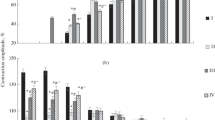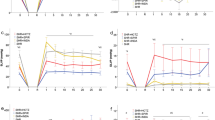Summary
The aim of this study was to clarify the role of altered diabetic vascular reactivity in ischaemic heart disease. In diabetic condition, the necrotic area of myocardial infarction was significantly extended and myocardial oedema failed to develop after administration of norepinephrine 2 or 48 hours after ligation of the left anterior descending coronary artery. In metabolically healthy dogs the necrotic area of myocardial infarction was considerably smaller and an increase in myocardial water content, in myocardial thiocyanate space, in microscopically demonstrable permeability and in diastolic stiffness of left ventricular wall occurred when norepinephrine was administered 2 or 48 hours after coronary infarction. A close correlation was demonstrable between enhanced water content, thiocyanate space and diastolic stiffness in metabolically healthy animals, whereas in diabetic condition diastolic stiffness was primarily increased, and decreased when norepinephrine was infused after coronary ligation. Therefore, the altered vascular reactivity in diabetes is supposed to be responsible for the lack of oedema in the nonischaemic part of myocardium after norepinephrine infusion as well as for the size and severity of myocardial infarction.
Zusammenfassung
Es wurde bewiesen, daß die Verabreichung von Noradrenalin 2 und 48 Stunden nach Okklusion der vorderen, absteigenden Koronararterie eine Erhöhung des Wassergehaltes, des Thiocyanat-Raumes, der mikroskopisch nachweisbaren Permeabilität sowie der diastolischen Steifheit in dem nichtischämischen Teil der linken Herzkammerwand hervorruft. Bei diabetischen Tieren war das ischämische Areal wesentlich größer, und es trat kein Myokardödem auf. Bei stoffwechselgesunden Tieren konnte eine strenge Korrelation zwischen den erhöhten Werten des Wassergehalts, des Thiocyanat-Raumes sowie der diastolischen Steifheit dargestellt werden. In diabetischen Tieren war dagegen die diastolische Steifheit von vornherein erhöht und nahm ab, wenn nach der Koronarunterbindung Noradrenalin infundiert wurde. Deshalb wird angenommen, daß die veränderte Gefäßreaktivität bei Diabetes sowohl für das Ausbleiben eines Ödems im nichtischämischen Anteil des Myokards nach Noradrenalin-Infusion verantwortlich ist als auch für Ausmaß und Schweregrad des Myokardinfarktes.
Similar content being viewed by others
References
Ahmed, S. S., G. A. Jaferi, R. M. Narang, T. J. Regan: Preclinical abnormality of left ventricular function in diabetes mellitus. Amer. Heart J.89, 153–158 (1975).
Barry, W. H., J. Z. Brocken, E. L. Alderman, D. C. Harrison: Changes in diastolic stiffness and tone of the left ventricle during angina pectoris. Circulation49, 255–263 (1974).
Blumenthal, H. T., M. Alex, S. Goldenberg: A study of lesions of the intramural coronary artery branches in diabetes mellitus. Arch. Path.70, 13–28 (1960).
Conard, V., J. R. M. Franckson, P. A. Bastenie, J. Kestens, L. Kovács: Étude critique du triangle d'hyperglycémie intraveineux chez l'homme et détermination d'un coefficient d'assimilation glucidique. Arch. Int. Pharmacodyn,93, 277–292 (1953).
Coulomba, J. J., L. Favreau: A new simple semimicro method for colorimetric determination of urea. Clin. Chem.9, 102–108 (1963).
Crandall, L. A. Jr., M. X. Anderson: Estimation of the state of hydration of the body by the amount of water available for the solution of sodium thiocyanate. Amer. J. Digest. Dis. Nutr.1, 126–131 (1934).
Dandona, P., I. M. James, M. L. Woollard, P. Newbury: Instability of cerebral blood-flow in insulin-dependent diabetics. The Lancet(1979) 8154, 1203–1205.
Diamond, G., J. S. Forrester: Effect of coronary artery disease and acute myocardial infarction of left ventricular compliance in man. Circulation45, 11–19 (1972).
Dubecz, E., S. Juhász-Nagy, G. Pogátsa, Gy. Gábor: Myocardial water content and thiocyanate space after administration of noradrenaline and drotaverine in dogs. J. Res. Comm. Sci. Med. Sci.3, 285 (1975).
Ewald, U., T. Tuemo, G. Rooth: Early reduction of vascular reactivity in diabetic children detected by transcutaneous oxygen Electrode. Lancet(1981) 8213, 1287–1288.
Fegler, G.: Measurement of cardiac output in anaesthetized animals by a thermodilution method. Quart. J. Exp. Physiol.39, 153–164 (1954).
Fogelman, A. M., A. S. Abbasi, M. L. Pearce, A. A. Kathus: Echocardiographic study of the abnormal motion of the posterior left ventricular wall during angina pectoris. Circulation46, 905–1013 (1972).
Hyvärinen, A., E. A. Nikkilä: Specific determination of blood glucose with o-toluidine. Clin. Chim. Acta7, 140–143 (1962).
Kiss, Á., Gy. Grosz, S. Juhász-Nagy, Gy. Szinay, M. Wagner, G. Pogátsa: Altered conductivity in femoral arterial bed in alloxan-diabetic dogs. Kisérletes Orvostudomány32, 490–494 (1980).
Królewski, A. S., D. Janeczko, A. Kobryn, B. Puncewicz: Survival after myocardial infarction in diabetic patients. Acta Med. Pol.16, 45–53 (1975).
Neuweiler, W.: Quantitative Bestimmung der Acetonkörper im Blut mittels des Stufenphotometers. Klin. Wschr.12, 869–980 (1933).
Nieminen, M., J. Heikkilä: Echoventriculography in acute myocardial infarction. II. Monitoring of left ventricular performance. Brit. Heart J.38, 271–281 (1976).
Pogátsa, G.: Altered adrenergic response of the coronary and femoral arterial bed in alloxan-diabetic dogs. Adv. Physiol. Sci.27, 213–226 (1980).
Pogátsa, G., M. Bihari-Varga, Gy. Szinay: Effect of diabetes therapy on the myocardium in experimental diabetes. Acta Diabetol. Latina16, 129–138 (1979).
Pogátsa, G., E. Dubecz, Gy. Gábor: The role of myocardial oedema in the left ventricular diastolic stiffness. Basic Res. Cardiol.71, 263–269 (1976).
Regan, T. J., P. O. Ettinger, M. I. Khan, M. U. Jesrani, M. M. Lyons, H. A. Oldewurtel, M. Weber: Altered myocardial function and metabolism in chronic diabetes mellitus without ischaemia in dogs. Circ. Res.35, 222–237 (1974).
Szentiványi, M., A. Juhász-Nagy: The physiological role of coronary constrictor fibres. II. The role of coronary vasomotors in metabolic adaptation of the coronaries. Quart. J. Exp. Physiol.48, 105–118 (1963).
Author information
Authors and Affiliations
Rights and permissions
About this article
Cite this article
Palik, I., Koltai, M.Z., Kolonics, I. et al. Effects of coronary occlusion and norepinephrine on the myocardium of alloxan-diabetic dogs. Basic Res Cardiol 77, 499–506 (1982). https://doi.org/10.1007/BF01907942
Received:
Issue Date:
DOI: https://doi.org/10.1007/BF01907942




